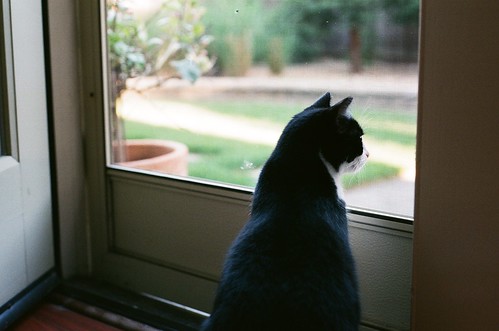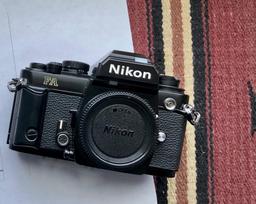The Nikon FA was introduced in 1983 and marketed as Nikon's most sophisticated techno-wonder. It was the first Nikon to incorporate multi-segmented metering. Twenty-five years later, Apple rolled out the iPhone X that utilizes computational photography with millions of lines of code executed with each tap of the shutter button. It is an incredible digital capture device.
When I work with analog, I also capture an iPhone image to use for my note taking. I thought you might be interested to see how things have evolved over the last 25 years. State of the art analog in the 1980s vs amazing 21st century tech.
 Kitty looking out the window. Nikon FA, Nikkor 50mm f/1.8, Program mode, matrix metering, Fujicolor 200 film. Un-retouched. Photo by Derrick Story.
Kitty looking out the window. Nikon FA, Nikkor 50mm f/1.8, Program mode, matrix metering, Fujicolor 200 film. Un-retouched. Photo by Derrick Story.
 Kitty looking out the window, iPhone X.
Kitty looking out the window, iPhone X.
I like this shot of Sylvester looking out the screen door because it is a backlit scene. (You might not realize that looking at the iPhone image. More on that later.) The Nikon FA with its new-fangled metering system actually does a wonderful job of determining the exposure in program mode. Any shortcoming in dynamic range is due to the latitude of the film.
The iPhone, on the other hand, does a great job of balancing both the main subject and the brighter background. There is more shadow detail in the dark fur, and the highlights are much more recovered.
Now the question is, which shot is more pleasing to the eye? Well, that's an individual decision, isn't it?
 Neon sign. Nikon FA, Nikkor 50mm f/1.8, Program mode, matrix metering, Fujicolor 200 film. Un-retouched. Photo by Derrick Story.
Neon sign. Nikon FA, Nikkor 50mm f/1.8, Program mode, matrix metering, Fujicolor 200 film. Un-retouched. Photo by Derrick Story.
 Neon sign. iPhone X. Un-retouched.
Neon sign. iPhone X. Un-retouched.
When I look at the neon sign image, I'm amazed by the highlight recovery in the iPhone X version. The sky in the upper left corner and the reflection on the top of the umbrellas are perfectly exposed.
The analog Nikon shot definitely displays more contrast. And to be honest, is a more accurate representation of the actual lighting. The shadows are darker and the reflections are bright. That's more how things looked at that time of day.
And that's what I've noticed with film photography... I get a better sense for the lighting because it hasn't been clipped on both ends of the histogram. Do I love the wild dynamic range of computational photography? Of course! It's such a luxury.
But along the way I don't want to lose my ability to read the scene, and to understand what's happening with the lighting. Film photography helps me stay sharp that way.
My bottom line is that I like both sets of images. And I feel lucky to have the option to choose which way to go for any given subject. And I might add, that I think the Nikon with a consumer roll of color film held up quite well. Not bad for an old man.
You can share your thoughts at the TDS Facebook page, where I'll post this story for discussion.












